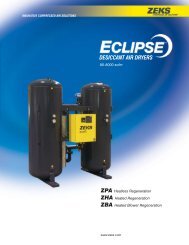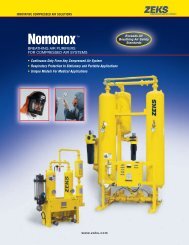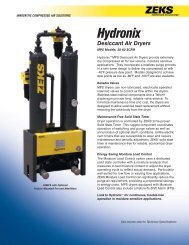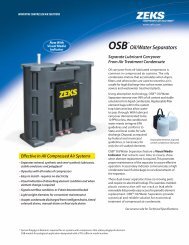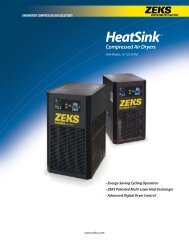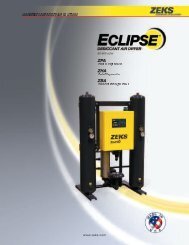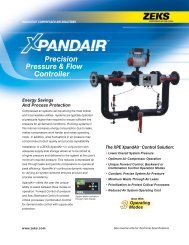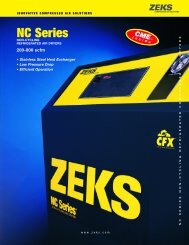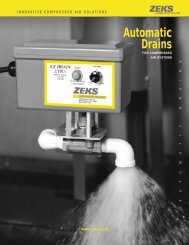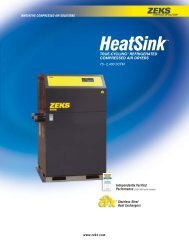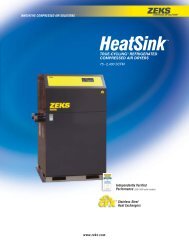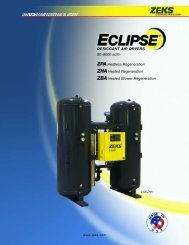Hi-Temp - ZEKS Compressed Air Solutions
Hi-Temp - ZEKS Compressed Air Solutions
Hi-Temp - ZEKS Compressed Air Solutions
You also want an ePaper? Increase the reach of your titles
YUMPU automatically turns print PDFs into web optimized ePapers that Google loves.
A Complete System<br />
For <strong>Hi</strong>gh <strong>Temp</strong>erature<br />
Applications<br />
<strong>Hi</strong>-<strong>Temp</strong>TM dryers are specifically engineered to provide<br />
efficient air treatment at high inlet air temperatures.<br />
Inlet air temperature, inlet air pressure and ambient air<br />
temperature have a significant effect on air dryer<br />
performance with inlet air temperature having the most<br />
dramatic effect. Raising the inlet temperature by 20°F<br />
approximately doubles the amount of moisture in the<br />
air stream and requires a larger dryer and more energy<br />
for the same amount of flow. <strong>Hi</strong>-<strong>Temp</strong>TM dryers are<br />
engineered to accommodate this increased moisture<br />
load and include all components necessary to provide<br />
compressed air treatment in a single unit. A separate<br />
aftercooler, separator and drain are not required when<br />
<strong>Hi</strong>-<strong>Temp</strong>TM is installed.<br />
As inlet pressure increases, the capacity of an air dryer<br />
increases since compressed air can hold less water<br />
vapor at higher pressures and requires less energy to<br />
dry. Locate the dryer at the highest feasible pressure<br />
point in the system to take advantage of this factor.<br />
The most common way to size the <strong>Hi</strong>-<strong>Temp</strong> TM dryer for<br />
your application is to match it to your air compressor<br />
horsepower as follows:<br />
<strong>Air</strong> Compressor Dryer Model Standard Flow Pressure Drop<br />
HP scfm psig<br />
5 HTA020 18 1.50<br />
7 1 ⁄2 HTA030 29 2.75<br />
10 HTA040 41 1.65<br />
15 HTA060 55 3.10<br />
20 HTA080 80 3.30<br />
25 HTA110 110 3.10<br />
30 HTA130 133 3.19<br />
Standard rating conditions for <strong>Hi</strong>-<strong>Temp</strong> TM dryers – 150 psig inlet air<br />
pressure, 180°F inlet air temperature and 100°F ambient air temperature.<br />
If your application is to be sized for conditions other<br />
than the standard <strong>Hi</strong>-<strong>Temp</strong> TM rating conditions and your<br />
flow requirement (SCFM) is known, the following<br />
correction factors apply to correct your flow:<br />
Correction Factors (Apply to desired air flow)<br />
Inlet <strong>Air</strong> <strong>Temp</strong>erature Ambient <strong>Air</strong> <strong>Temp</strong>erature<br />
°F Correction Factor °F Correction Factor<br />
100 0.30 80 0.80<br />
125 0.50 90 0.89<br />
150 0.75 100 1.00<br />
180 1.00 110 1.16<br />
200 1.08 120 1.30<br />
Example:<br />
45 SCFM air flow<br />
175 psig inlet air pressure<br />
150°F inlet air temperature<br />
110°F ambient temperature<br />
Step 1:<br />
Correct for inlet air and ambient temperature effects on<br />
capacity, by using the appropriate correction factors<br />
listed in the above tables.<br />
Inlet Ambient <strong>Temp</strong>erature<br />
<strong>Air</strong> Flow <strong>Temp</strong>. <strong>Temp</strong>. Corrected<br />
Correction Correction <strong>Air</strong> Flow<br />
45 SCFM x 0.75 x 1.16 = 39 SCFM<br />
Step 2:<br />
Correct for the inlet air pressure effect on capacity, by<br />
using the selection chart on the back of this brochure.<br />
Begin by choosing the required dew point and the<br />
compressor’s discharge air pressure.<br />
Next, follow this line horizontally and select the dryer<br />
with the capacity calculated in step 1, or the next larger<br />
model. For the above example, you would select a<br />
model HTA040.<br />
Notice in the specifications table on the back of this<br />
brochure that approximately 4% more air flow can be<br />
accommodated if a 50°F dew point is selected.



